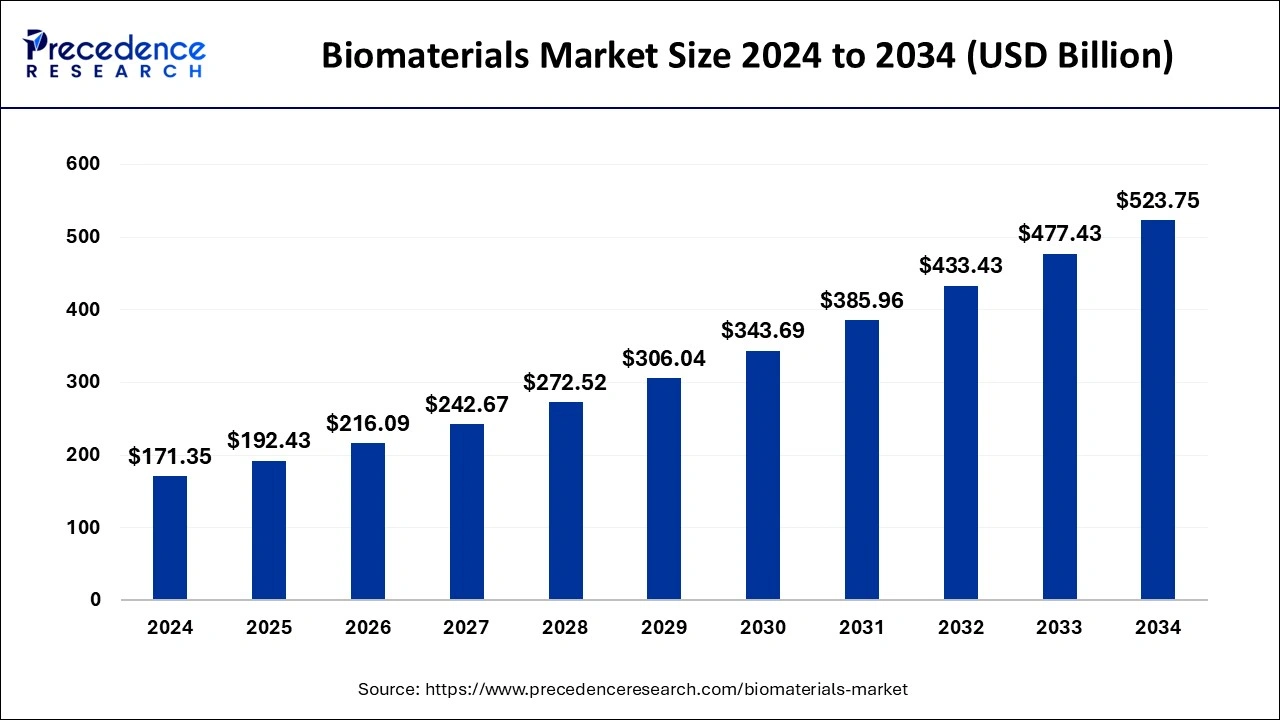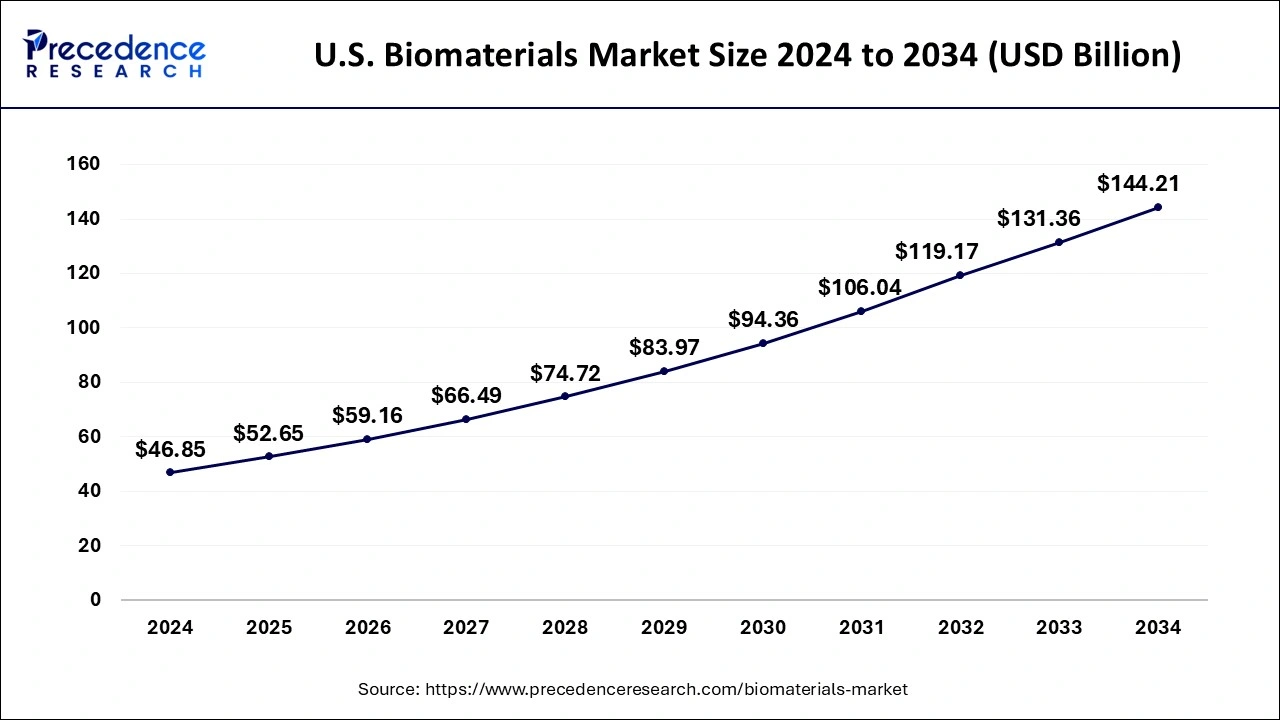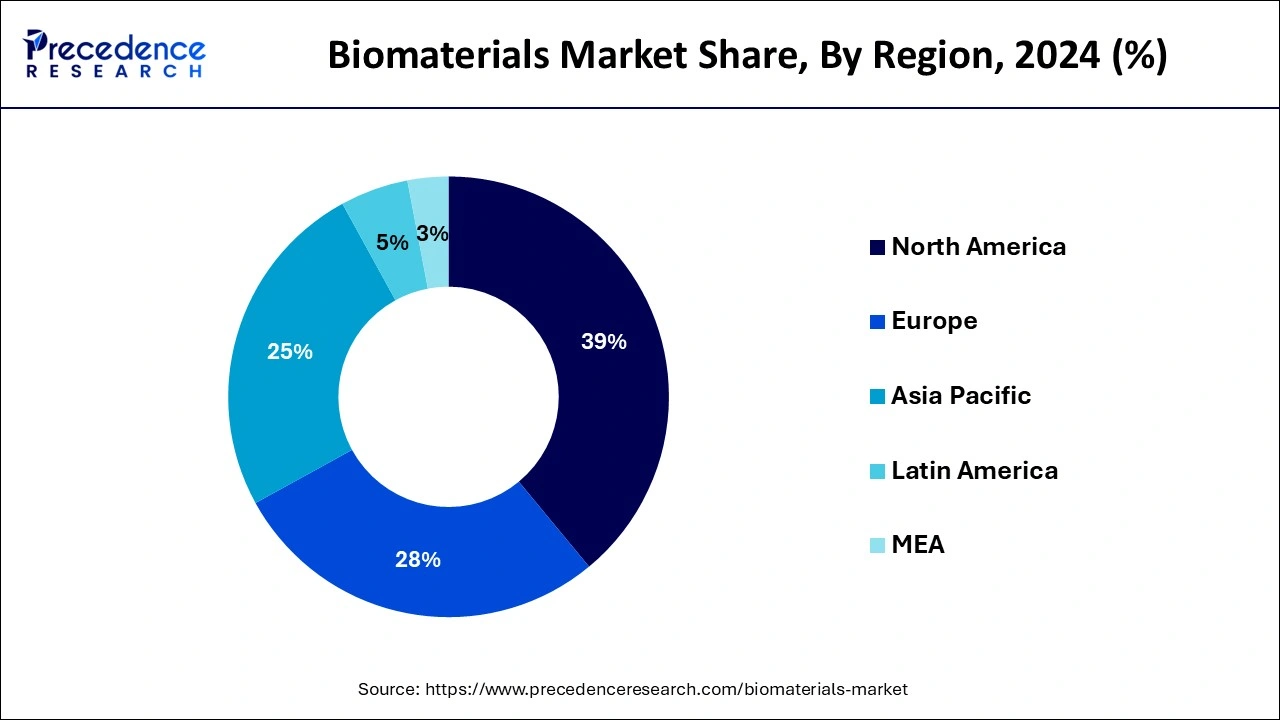What is the Biomaterials Market Size?
The global biomaterials market size is valued at USD 192.43 billion in 2025 and is predicted to increase from USD 216.09 billion in 2026 to approximately USD 523.75 billion by 2034, growing at a CAGR of 11.82% from 2025 to 2034.

Biomaterials Market Key Takeaways
- North America has accounted revenue share of over 39% in 2024.
- Product, the polymer segment has accounted highest revenue share in 2024.
- Application, the orthopedic segment has held a revenue share of over 24% in 2024.
AI in the Market
AI is playing a significant role in the transformation of the biomaterials market by fast-tracking the discovery, design, and optimization of new materials with the desired biological properties. Predictive modeling and generative algorithms allow the design of materials at the molecular level as per the clinical requirements. AI is a big help in the manufacturing process of 3D printing, electrospinning, and biofabrication, making sure that quality and consistency are maintained. In the biomedical field, AI is making it possible to have personalized biomaterials that are patient-specific, e.g., for drug delivery, implants, and tissue regeneration. Explainable AI (XAI) is the one giving confidence to researchers and doctors as it provides the transparency of the model predictions.
Market Overview
The biomaterials market is a wide-spread industry that revolves around the production and application of products or materials that interact with biological systems. These materials are used in multiple healthcare applications, such as implants, prosthetics and tissue engineering. The global market offers a wide range of materials like polymers, ceramics and composites, designed to be biocompatible and serve specific functions within the human body.
Biomaterials are widely used in dental applications, ophthalmology, cosmetic surgeries, drug delivery systems and wound healing. In addition, biomaterials are widely used to create various medical implants, such as artificial joints and cardiac stents.
The market's current position is observed to get accelerated as the industry is witnessing advancements in medical technology and improvements in the quality of healthcare services. Significant research and development activities are also observed to promote the market's expansion in the upcoming period.
Biomaterials Market Growth Factors
Rising prevalence of chronic skeletal and musculoskeletal medical conditions are predicted to propel the demand for biomaterial-based implants, thereby fuelling the market growth. Further, technological advancements have made biomaterials more diverse and have increased their application in various fields such as tissue engineering and bioengineering. The advent of smart biomaterials drives the revenue generation in this market. Increasing demand for smart biomaterials that transfer and produce bioelectric signals similar to body tissues for accurate physiological functions predicted to surge the market growth. Piezoelectric scaffold is a smart material that plays a significant role in tissue engineering.
- Musculoskeletal disorders' increased prevalence is one of the reasons that biomaterial-based implants are rising.
- Better technologies are opening new avenues for the use of biomaterials in tissue engineering, bioengineering, and regenerative medicine.
- Smart biomaterials are coming up, which can imitate the natural tissue functions and, at the same time, give out bioelectric signals.
- More and more money is being invested in R&D for biomaterials, which will result in better biocompatibility, durability, and regenerative properties.
- The usage of biomaterials in healing wounds, repairing the heart, and in drug delivery systems is increasing.
Data and Statistics
- A global leader in biomaterial production and distribution, Evonik stated its expenditure for research and development activities to be €460 million in 2022. The company's sales reached €18.5 billion.
- Evonik's EBITDA reached €450 million in the second quarter (Q2) of 2023, which was €409 million in Q1 2023.
- MedTech by Johnson and Johnson, a prominent player for biomaterial production witnessed overall sales of $27.4 billion, this is an increase of 1.4% from 2021.
- The Canadian government in December 2022 invested $127 million in order to keep its bioscience facilities at cutting-edge. The investment has been made for research and development along with biomanufacturing purposes.
- According to American Joint Replacement Registry Annual Report for 2022, hip and knee procedures in America have registered a whopping growth of 14% as compared to the year 2021.
Market Scope
| Report Highlights | Details |
| Market Size in 2025 | USD 192.43 Billion |
| Market Size in 2026 | USD 216.09 Billion |
| Market Size by 2034 | USD 523.75 Billion |
| Growth Rate from 2025 to 2034 | CAGR of 11.82% |
| Largest Market | North America |
| Base Year | 2025 |
| Forecast Period | 2025 to 2034 |
| Segments Covered | Product, Application, Region |
| Regions Covered | North America, Europe, Asia-Pacific, Latin America, and Middle East & Africa |
Market Dynamics
Driver
The rising rate of cosmetic surgeries
A report published by the International Society of Aesthetic Plastic Surgery stated that there was an overall 11.2% increase in procedures done by plastic surgeons in 2022. The report also stated that there were more than 14.9 million surgical procedures done in 2022 worldwide.
The demand for cosmetic surgeries and minimally invasive procedures has been on the rise in recent years. People are increasingly seeking enhancements to their physical appearance. This demand includes procedures such as facelifts and dermal fillers that require biomaterials. ongoing advancements in biomaterials have allowed safer and quicker cosmetic procedures. These biomaterials are designed to be biocompatible, reducing the risk of adverse reactions or complications. As the cosmetic industry expands, it is observed that the innovation of improved biomaterials will also increase. Thereby, the element is expected to sustain as a driver for the market.
Restraint
Regulatory hurdles
The market for biomaterials (production and distribution) is observed to be affected by regulatory hurdles or regulatory challenges. The market is subjected to strict regulatory oversight due to safety concerns. Meeting these requirements can be time-consuming and costly. Such regulatory hurdles can directly impact on the production or investment in biomaterials industry. Regulatory hurdles can even increase the timeline for production of biomaterials. Thereby, the element associated with regulatory hurdles acts as a major restraint for the market.
Opportunity
Innovation in techniques for biomaterial production
Technological advancements allow for the development of new biomaterials with enhanced properties. This also expands the range of materials available for various applications, catering to specific needs in the medical and healthcare sectors. Innovations in biomaterial production are observed to lead to materials that are more biocompatible for the human body. Innovations in the production of biomaterials also broaden the range of potential applications and increase patient safety. Thereby, the element is observed to offer several potential opportunities for the market to expand.
Product Insights
By product, the polymer segment led the global biomaterials market with considerable revenue share in 2024 and projected to continue its dominance in the coming years. This is mainly attributed to the wide range of applications of polymer products. Wide availability of biopolymers along with need for advanced polymers for bio-resorbable tissue fixation application and other orthopedic applications expected to escalate the revenue growth of the segment.
Polymeric biomaterials are one of the keystones of tissue engineering. Continued progression in technologies, such as surface modification, micro manufacturing, nanotechnology, drug delivery, and high-throughput screening, play an important role in expanding the polymeric material usage in the tissue engineering field.
On the other hand, natural biomaterials anticipated to register the highest growth rate over the forecast period due to numerous benefits offered by the product over synthetic biomaterials related to biocompatibility, biodegradability, and remodeling. In the wake of these advantages, natural biomaterials are increasingly used for restoration and replacement of structure as well as function of the damaged tissues or organs.
Application Insights
The orthopedic application segment captured maximum revenue share in the global biomaterials market in 2024. Rising adoption of metallic biomaterials owing to their high load bearing capacity is one of the prime factors that drive the growth of the segment. Besides this, significant developments and on-going investments for the advancement in orthopedic implants by market participants are likely to propel the market growth in the next years to come. For instance, in November 2019, FDA approved Xiphos-ZF spinal interbody device introduced by DiFusion Inc. that is based on Zfuze, a different biomaterial that is made up of titanium and poly-ether-ether-ketone.
According to a study presented at the 2023 American Academy of Orthopaedic Surgeons (AAOS) Annual Meeting. The study, “Epidemiology of Sports Injuries Among High School Athletes in the United States,” found that an estimated 5,228,791 sports injuries occurred nationally. The study notes that the epidemiologic data have been updated since 2006.
Moreover, plastic surgery analyzed to grow at a significant pace during the forecast period owing to increasing number of cosmetic procedures along with significant application of biomaterials in such surgeries. According to the International Society of Aesthetic Plastic Surgery report 2019, nearly 4.3 Million cosmetic procedures were performed in the U.S. during the year 2018 that positively influences the growth of the segment.
Regional analysis
North America
North America is the largest market for biomaterials, mainly thanks to its superior healthcare infrastructure, robust research ecosystem, and quick adoption of state-of-the-art medical technologies. The area's dedication to innovation and regulatory backing for medical device approvals allows for a quicker launch of new biomaterials in the market. The primary concentration on orthopedic, cardiovascular, and dental applications, together with massive funding for research institutions, is still reinforcing North America's dominance.
Asia-Pacific
The Asia-Pacific region is the fastest-growing market, getting support from the improving healthcare facilities, a large elderly population, and the demand for both inexpensive and advanced medical solutions is rising. The local manufacturing capabilities development and the government's rising support for healthcare innovations are the other factors contributing to the market's growth. The fast adoption of regenerative medicine and bioprinting technologies is another thing that makes the region more competitive.
Europe
Europe is showing steady growth, which is the result of the continent's focus on quality healthcare, an aging population, and novelties in nanostructured and bio-inspired materials. Although the regulatory environment is stricter, the region still manages to make progress in orthopedic and cardiac biomaterials, thanks to strong links between industry and research, plus funding for R&D.
U.S. Biomaterials Market Size and Growth 2025 To 2034
The U.S. biomaterials market size was valued at USD 52.65 billion in 2025 and is expected to reach USD 144.21 billion by 2034, poised to grow at a CAGR of 12% from 2025 to 2034.

In terms of revenue, North America dominated the global biomaterials market due to initiatives taken by different private and public organizations. Some of the organizations include the National Institute of Standards and Technology and the National Science Foundation that provide assistance and knowledge pertaining to usage of biomaterials in various biomedical applications. This resulted in significant growth in the adoption of biomaterials in the region.
In May 2025, Nexture Bio unveiled a robust suite of custom research and development services. The services are designed to support customers in optimizing cell culture on ACF microcarriers and scaffolds, scaling adherent cell culture bioprocesses, formulating and building ACF microcarriers or scaffolds for their specific applications, and more. Services are delivered from two specialized facilities in Vacaville, California, and Xenia, Ohio, where each facility is purpose-built for biomaterials production and cell culture work.
The rising demand for cosmetic surgeries is anticipated to accelerate the market's revenue during the forecast period. For instance, according to the 2023 ASPS Procedural Statistics, cosmetic plastic surgery has steadily grown, as patients continue to place increased value on their physical and aesthetic health. In 2023, the number of Cosmetic Procedures reported by American Society of Plastic Surgery (ASPS) members rose by 5%. In 2022, 1,498,361 cosmeticplastic surgery procedures were performed, and in 2023, this number increased to 1,575,244. These procedures include breast, body, and facial plastic surgery procedures. Over 1.5 million cosmetic plastic surgeries were performed in the United States by American Society of Plastic Surgery (ASPS) members in 2023, an increase of 5% since 2022. Cosmetic Breast Procedures account for about one-third of all the cosmetic procedures performed by board-certified plastic surgeons. Breast Augmentation remains the most popular cosmetic breast procedure. In 2023, over 300,000 Breast Augmentations were performed.
On the other hand, the Asia Pacific anticipated to witness the fastest growth during the analysis period. This is attributed to the major strategies adopted by the regional players to reinforce their presence in both global as well as regional market. For instance, in 2019, Mitsubishi Chemical, a Japan-based company, acquired thermoplastic polyurethane elastomer business from U.S.-based AdvanSource Biomaterials. The acquisition analyzed to help the company to expand its footprint in the global market along with capturing significant share in the international market.

Key Companies & Market Share Insights
The global biomaterials market is highly competitive due to significant investments from market players to maintain a competitive edge and expand their presence. These vendors also adopt inorganic growth strategies such as partnerships, agreements, collaboration, and merger & acquisition to strengthen their product portfolio. They also invest in the development of biomaterials to expand their offerings.
Biomaterials Market Companies
- Evonik Industries AG
- Medtronic plc
- Berkeley Advanced Biomaterials
- Corbion
- Carpenter Technology Corporation
- Zimmer Biomet Holdings, Inc.
- Invibio Ltd.
- Covalon Technologies Ltd.
- BASF SE
- Johnson & Johnson
- Stryker Corporation
- CoorsTek Inc.
- DentsplySirona
- Collagen Matrix, Inc.
Recent Developments
- In April 2025, Northern Illinois University (NIU) launched a cutting-edge biomaterials and tissue engineering laboratory, significantly enhancing the biomedical engineering programme. This new laboratory offers students the opportunity to engage in experiments involving liquids, chemicals, and biological matter. The facility is designed to grow and study mammalian cells, which make up the tissues and organs of mammals.
- In May 2025, PetVivo Holdings, Inc. and PiezoBioMembrane, Inc. announced a transformative Master Services Agreement. The strategic partnership centers on collaborative research and development of revolutionary functional biomaterials that include piezoelectric nanofibers incorporated into a biocompatible biomaterial comprised of natural materials that mimics mammalian extracellular matrix (“ECM”).
- In September 2024, Temple OrthoBiologics, a new venture spun out from women's health company Temple Therapeutics, proudly announced its official launch heralding a breakthrough in orthopedic sports medicine. For years, the prevention of scar tissue was considered impossible, and the company is set to change that narrative.
- In September 2023, altM, a biomaterial startup announced that it has raised $3.5 million in seed funding led by Omnivore. altM aims to develop scalable biomaterials to help large industries. The startup is known for using agricultural residues for production to reduce carbon footprints.
- In September 2023, the University of Birmingham stated that they have launched dental and biomaterial testing center. The center aims to offer comprehensive testing services to assess the mechanical and physical properties of materials.
- In June 2023, IFF announced the launch of its newly designed enzymatic biomaterial technology. The technology aims to focus on the development of biomaterial at a scale. The potential of this technology has already been demonstrated across various industries.
Value Chain Analysis
- Feedstock Procurement: The process of obtaining biological raw materials such as plant-based compounds or agricultural residues for the production of biomaterials.
Key Players: Stora Enso, Drax Group plc, Enviva Inc. - Chemical Synthesis and Processing: The transformation of raw biological feedstocks into either functional chemical intermediates or the final forms of biomaterials.
Key Players: SABIC, Corbion, and NatureWorks - Compound Formulation and Blending: The mix of several materials to have the desired characteristics, like strength, elasticity, or biocompatibility.
Key players: Evonik Industries, Corbion, Covestro AG, DuPont - Quality Testing and Certification: The performance and regulatory compliance of the product are guaranteed through the stringent testing that is done.
Key Players: TÜV Rheinland, Eurofins Scientific, Quality and Accreditation Institute (QAI) - Regulatory Compliance and Safety Monitoring: The whole production chain is monitored for environmental, safety, and legal standards compliance.
Key players: APCER Life Sciences, IQVIA
Segments Covered in the Report
By Product
- Metallic
- Ceramics
- Natural
- Polymers
By Application
- Ophthalmology
- Intraocular Lens
- Synthetic Corneas
- Ocular Tissue Replacement
- Others
- Cardiovascular
- Stents
- Sensors
- Implantable Cardiac Defibrillators
- Guidewires
- Vascular Grafts
- Pacemakers
- Others
- Dental
- Dental Implants
- Tissue Regeneration Materials
- Bone Grafts & Substitutes
- Others
- Wound Healing
- Adhesion Barrier
- Surgical Hemostats
- Fracture Healing Device
- Internal Tissue Sealant
- Skin Substitutes
- Others
- Orthopedic
- Orthobiologics
- Joint Replacement Biomaterials
- Viscosupplementation
- Spine Biomaterials
- Bioresorbable Tissue Fixation Products
- Others
- Plastic Surgery
- Soft Tissue Fillers
- Facial Wrinkle Treatment
- Bioengineered Skins
- Craniofacial Surgery
- Acellular Dermal Matrices
- Peripheral Nerve Repair
- Others
- Tissue Engineering
- Neurology
- Shunting Systems
- Neural Stem Cell Encapsulation
- Cortical Neural Prosthetics
- Hydrogel Scaffold For CNS Repair
- Others
- Others
By Region
- North America
- Latin America
- Europe
- Asia-pacific
- Middle and East Africa
For inquiries regarding discounts, bulk purchases, or customization requests, please contact us at sales@precedenceresearch.com
Frequently Asked Questions
Ask For Sample
No cookie-cutter, only authentic analysis – take the 1st step to become a Precedence Research client
 sales@precedenceresearch.com
sales@precedenceresearch.com
 +1 804-441-9344
+1 804-441-9344